
It’s Saturday in New York, in early summer, and outside it’s deadly hot—the kind of day that makes you want to hide in your apartment and drink ice-cold lemonade, with the A.C. blasting. But, in one of the ballet studios at Lincoln Center, a pas de deux is being made, step after agonizing step. David Hallberg, of American Ballet Theatre, and Natalia Osipova, of the Royal Ballet, are working with Alexei Ratmansky, a Russian-born choreographer who, for the past nine years, has been the resident dance-maker at A.B.T.
Hallberg and Osipova are big stars. In 2011, the South Dakota-born Hallberg became the first American to join the Bolshoi Ballet as a dancer of the highest rank (principal). Just to see him walk across the stage is a thing of beauty. Osipova started out at the Bolshoi—Ratmansky hired her—and then became a kind of international phenomenon. Critics have run out of words to describe her dancing: explosive, sensational, stratospheric. And she is all those things. There is something radical about the energy with which she blasts through space; ballet’s fastidious rules don’t apply to her.
They first danced together in 2009, in the Romantic ballet “Giselle,” in New York. On the face of it, the matchup, which happened because of another dancer’s injury, seemed odd: this tiny force of nature, paired with this lanky, delicate prince. He was naturally elegant and rather reticent; she was emphatic and uncontainable, with a jump that came out of nowhere and propelled her way up into the air, so that she looked more like a bouncing ball than a ballerina. It wasn’t at all what you expected from Giselle, who is usually depicted as demure and rather sickly. Lo and behold, they clicked. More than that, each seemed galvanized by the other.
They danced together for a few seasons, until Hallberg suffered a major injury that took him out for almost two years—an eternity in dance terms. It was, in part, the desire to dance with her again that kept him going. “Every day,” he told me last year, “I thought of what I felt with her onstage.”
I am reminded of this as I watch the two work on the tricky pas de deux Ratmansky is making for them. (It will be officially unveiled in September at Sadler’s Wells, in London, as part of an evening of new dances.) When they first met, they didn’t have a language in common, so mostly they just grinned at each other and let their bodies do the talking. Now that she’s based in London, her English has improved, and he has learned some Russian. Ratmansky, who has lived in the U.S. for almost a decade, switches back and forth between the two languages. They have an easy intimacy; she cracks jokes, he laughs, then they work some more.
The rehearsal begins in silence. Osipova pulls a baby-blue skirt over her lilac leotard and gathers her hair into a messy top knot. Though she’s tiny, there’s nothing dainty about her. Her back is a smooth, finely-sculpted expanse of muscle. She and Hallberg begin going over the steps they’ve learned so far, sketching them out with their hands, the way dancers do. Twirling a finger around in the air represents a turn, bending both arms at the elbow while drawing their hands upward signifies a jump. Osipova has a funny habit of squinting her right eye and twiddling her fingers when she’s concentrating. Ratmansky, astride a chair at the front of the room, watches them, occasionally reminding them of what comes next.
Then, suddenly, as if he can no longer resist the urge, he gets up and shows a sequence of steps, a series of frisky jumps. As he catches a glimpse of himself in the mirror, he laughs at his reflection—he’s no longer in dancer shape—but, in truth, the way he executes the steps gives a clearer sense of the timing and dynamics than any explanation.
They work on a few phrases of movement for about an hour, altering a step here, fixing a lift there. Ratmansky works like a sculptor; he keeps scraping away at the shapes, making small adjustments until the dancers’ bodies, in motion and in stillness, take on an interesting three-dimensional quality. Every angle and tilt adds a new shading. These minute nuances matter as much as the actual steps. “Lead with the chest,” “lighten your knees,” “soften the neck,” “here, a more collapsing feeling.” Sometimes it seems as if he might never be satisfied. “Does he ask for too much?” I suggest to Hallberg later. “In a way, he does,” he replies. “I think it’s his way of getting everything he can out of the dancers he works with.”
Toward the end of the pas de deux, Ratmansky asks Osipova to pull away from Hallberg and fall to the ground. He spends what seems like an eternity figuring how exactly she should fall, doing it himself in five or six different ways: falling to the right; falling to the left; falling with an extra twist at the end; looking forward; looking down. She watches, squinting, then tries out different options, over and over. The most important thing, Ratmansky points out, “is to be on time.” The steps may look spontaneous, but in fact they’re rigorously structured. Everything happens at a precise moment, timed to a particular sound in the music. That’s what makes it appear inevitable.
After another half hour, the three of them decide to run through the choreography from start to finish. Another dancer, functioning as an assistant, switches on the sound system. The music is a slow, tenebrous waltz by the Finnish composer Jean Sibelius, “Valse Triste.” Why this piece? I ask Ratmansky later. “I always wanted to choreograph it for me and Tatiana,” his wife, also a former dancer. In the nineties, before he became a well-known choreographer, the two of them used to tour all over the Soviet Union performing small pieces of his creation at galas. “But I never did.”
About two-thirds of the way through, the waltz speeds up, working itself up to a feverish lather. Osipova and Hallberg begin to run. A few steps in, she launches herself several feet forward into a headlong dive; Hallberg catches her, spins her around, and gently sets her down on her feet, only to chase after her again, arriving just in time to catch her a second time, then a third.
Watching Osipova in close quarters produces a strange sensation—like seeing a large wave bearing down on you, just as it begins to crest in preparation for the crash. The first thing you feel is her utter fearlessness. She would jump, even if there were nobody there to catch her. You also become intensely aware of the efficiency of her body, a finely tuned machine in which each part labors in perfect harmony with all the others to achieve a single goal: movement through space.
In that moment, the underlying idea of the pas de deux becomes clear. It’s about a force that cannot be contained—an abstract notion, but easily translatable into musical and human terms. “You have six minutes to decide if you want this man,” Ratmansky tells Osipova. She laughs. For now, all bets are off.
Sourse: newyorker.com






